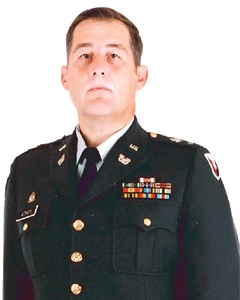Chief Warrant Officer 5
Michael J. Athey
 Born in
Chicago, Illinois, on October 18, 1950, Michael Athey joined the Army in 1970. After serving as an Armor
crewman and tank commander, he taught turret maintenance and gunnery at the US Army Armor School at Vilseck,
Germany, and was appointed an Ordnance Armament Maintenance Technician in 1977.
Born in
Chicago, Illinois, on October 18, 1950, Michael Athey joined the Army in 1970. After serving as an Armor
crewman and tank commander, he taught turret maintenance and gunnery at the US Army Armor School at Vilseck,
Germany, and was appointed an Ordnance Armament Maintenance Technician in 1977.
Athey's initial assignment as a Warrant Officer was as an Armament Repair Technician first in E Company and then in B Company, 124th Maintenance Battalion, 2nd Armored Division, Fort Hood, Texas. While serving at Fort Hood, from 1977 to 1982, he devised a test bench for troubleshooting laser rangefinders that saved the Army millions of dollars. He also obtained and renovated obsolete vans to accommodate the Abrams Tank and Bradley Fighting Vehicle diagnostic and component repair system.
From 1982 to 1985, Athey served as the Armament Section Chief and Platoon Leader in D Company, and then as Armament Maintenance Technician in B Company, 1st Forward Support Battalion, 3rd Infantry Division (Mechanized), Germany. Based on his recognized expertise on the M1 Abrams Tank, Athey was chosen to be the officer-in-charge of the maintenance team supporting the winning US team in the high-visibility Canadian Army Trophy tank gunnery competition in 1983.
He returned to Fort Hood in 1985, where he served until 1989 as Armament Maintenance Technician in B Company, 1st Forward Support Battalion, then as Armament Maintenance Technician in B Company, 502nd Forward Support Battalion, 2nd Armored Division. In these assignments, he developed troubleshooting procedures for the M1 Gunner's Primary Sight (GPS) that were incorporated into the Abrams technical manuals. He also devised new procedures for the repair of Line Replaceable Units (LRUs) previously coded out as nonrepairable, saving millions of dollars in repair parts and increasing the division's M1 tank readiness to 98 percent.
Next, Athey served from 1989 to 1990 as Armament Maintenance Technician in E Company and then as Armament Repair Technician in D Company, 702nd Main Support Battalion, 2nd Infantry Division, South Korea. At the conclusion of these assignments, he returned to Fort Hood again, where he became involved in testing, modifying, and improving the M1A2 Abrams tanks' software. From 1992 to 1994, he served as Field Site Chief, Materiel Fielding Team, Program Executive Office, Armored Systems Modernization, at Fort Carson, Colorado, where he began a series of key assignments in fielding the latest model M1 tanks to US and Allied forces.
From 1994 to 1995, Athey provided hands-on assistance and troubleshooting and diagnostic expertise as part of a $2.98 billion M1A2 Abrams fielding program for the Saudi Arabian Army. Then, from 1995 to 1998, he served as Field Site Chief, Program Executive Office, Armored Systems Modernization, Materiel Fielding Team. In fielding M1A2 Abrams tanks at Fort Hood, he executed two modification efforts that saved the Abrams Project Manager $1.1 million.
Chief Warrant Officer Five Athey retired in 1998 after 28 years of dedicated service to the Army and the Ordnance Corps. He is currently a Department of the Army civilian and Chief of the Tank-automotive and Armaments Command Materiel Fielding Team at Fort Hood, where he continues the work of fielding the newest model Abrams tanks to the Army.